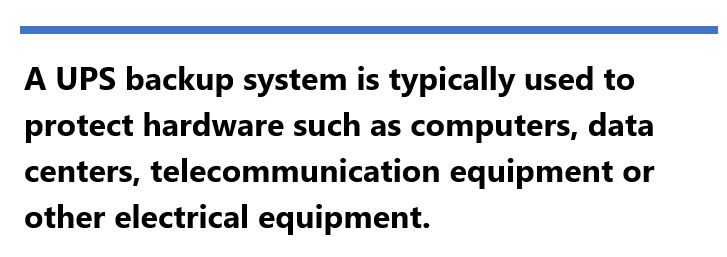If you have concerns about your power supply following an outage, then you should consider an uninterruptible power supply source. UPS battery backup is a good option for companies concerned about their power supplies in the event of a power outage, and here’s why:
An uninterruptible power supply (UPS) allows businesses to maintain electrical power to their critical technology, even during emergencies when service is interrupted. It also provides input voltage line conditioning. UPS replacement batteries are available as well as related products, and we provide installation services for all our clients, both big and small.
In addition to sales and installation, Phoenix Technology also offers maintenance and repair services. Our customers know they are getting service from an expert with UPS battery backup system experience. Our UPS maintenance services provide crucial support to the telecom, medical, communications, and other industries that need to have uninterrupted power.
There are several reasons to consider using backup power equipment, including line conditioning, surge protection, as well as providing uninterruptible power during power outages.
What is An Uninterruptible Power Supply?
An uninterruptible power supply, also uninterruptible power source, UPS or battery/flywheel backup, is an electrical apparatus that provides emergency power to a load when the input power source or mains power fails.
A UPS differs from an auxiliary or emergency power system or standby generator in that it will provide near-instantaneous protection from input power interruptions, by supplying energy stored in batteries, supercapacitors, or flywheels.

The on-battery runtime of most uninterruptible power sources is relatively short (only a few minutes) but sufficient to start a standby power source or properly shut down the protected equipment.
A UPS backup system is typically used to protect hardware such as computers, data centers, telecommunication equipment or other electrical equipment where an unexpected power disruption could cause injuries, fatalities, serious business disruption or data loss. UPS units range in size from units designed to protect a single computer without a video monitor (around 200-volt-ampere rating) to large units powering entire data centers or buildings.
The world's largest UPS, the 46-megawatt Battery Electric Storage System (BESS), in Fairbanks, Alaska, powers the entire city and nearby rural communities during outages.
Common Power Problems UPS Battery Backup Can Correct
The primary role of any UPS battery is to provide short-term power when the input power source fails. However, most UPS units are also capable of varying degrees of correcting common utility power problems such as:
- Voltage spike or sustained overvoltage;
- Momentary or sustained reduction in input voltage;
- Noise, defined as a high-frequency transient or oscillation, usually injected into the line by nearby equipment;
- Instability of the mains frequency;
- Harmonic distortion, defined as a departure from the ideal sinusoidal waveform expected on the line.
UPS battery backup units are divided into categories based on which of the above problems they address, and some manufacturers categorize their products in accordance with the number of power-related problems they address.
The Three UPS Battery Technologies
The three general categories of modern UPS systems are on-line, line-interactive and standby. An on-line UPS uses a "double conversion" method of accepting AC input, rectifying to DC for passing through the rechargeable battery (or battery strings), then inverting back to 120 V/230 V AC for powering the protected equipment.
A line-interactive UPS maintains the inverter in line and redirects the battery's DC current path from the normal charging mode to supplying current when power is lost. In a standby ("off-line") system the load is powered directly by the input power and the backup power circuitry is only invoked when the utility power fails. Most UPS systems below 1 kVA are of the line-interactive or standby variety which is usually less expensive.
For large power units, Dynamic Uninterruptible Power Supplies (DUPS) are sometimes used. A synchronous motor/alternator is connected to the mains via a choke. Energy is stored in a flywheel. When the mains power fails, an eddy-current regulation maintains the power to the load as long as the flywheel's energy is not exhausted. DUPS are sometimes combined or integrated with a diesel generator that is turned on after a brief delay, forming a diesel rotary uninterruptible power supply (DRUPS).
A fuel cell UPS has been developed in recent years using hydrogen and a fuel cell as a power source, potentially providing long run times in a small space.
A Sound Choice for Today’s Businesses
After reading this, it’s no surprise to you what an advantage a UPS battery backup system is for any business. Our clientele is made from many industries and market sectors, but all have this in common: the desire to carry-over power supply during an outage.
We would term this a virtually indispensable item in any business’ technology infrastructure.
Let Phoenix Technology Establish Your Emergency Power Supply Solution!
Phoenix Technology, Inc. is a trusted leader in providing managed IT services in Portland OR, Vancouver WA, and across the Pacific NW.
If you have any concerns about surviving a power outage, contact one of our IT experts about our UPS battery backup solutions at (360) 433-6930 or send us an email at info@phoenixtechnologyit.com or info@phoenixtechnology.us, and we will be happy to answer any and all your questions.



Leave a comment!